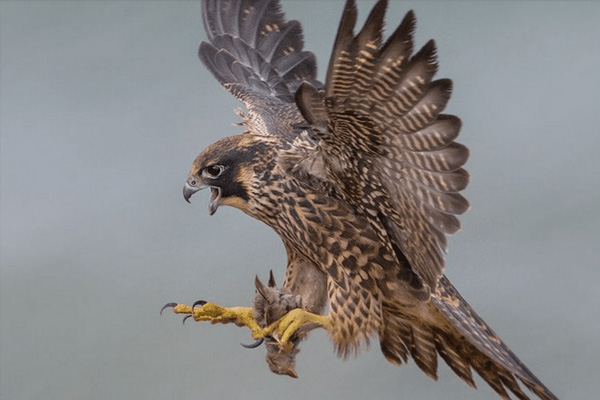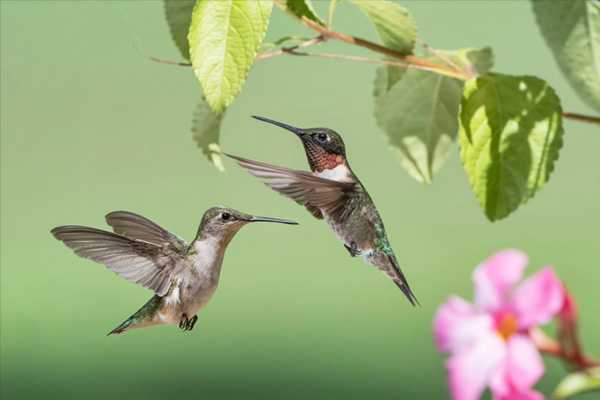5 Types of Falcons in Arizona (With Photos)
Falcons in Arizona are a stunning part of the Sonoran Desert’s wildlife. These powerful raptors soar above the rugged landscape, showcasing incredible speed and agility. Research into their habits reveals their vital role in this unique ecosystem. Witnessing a falcon in flight is a reminder of nature’s raw beauty and resilience. Their presence highlights ongoing conservation efforts. Discovering more about these birds is like unlocking a secret of Arizona’s wild heart.
1. Peregrine Falcon
- Scientific name: Falco peregrinus
- Size: 14-19 inches in length, 3.3-foot wingspan
- Weight: 18.7-56.4 ounces
- Lifespan: Up to 15-20 years in the wild
- Diet: Primarily birds, occasionally bats and other small mammals
The peregrine falcon is a true marvel of nature, holding the title of the fastest animal on Earth. These sleek, powerful birds can reach speeds of over 240 miles per hour during their hunting dives, known as stoops. With slate-gray backs, barred white undersides, and distinctive “mustache” markings, peregrines are a sight to behold.
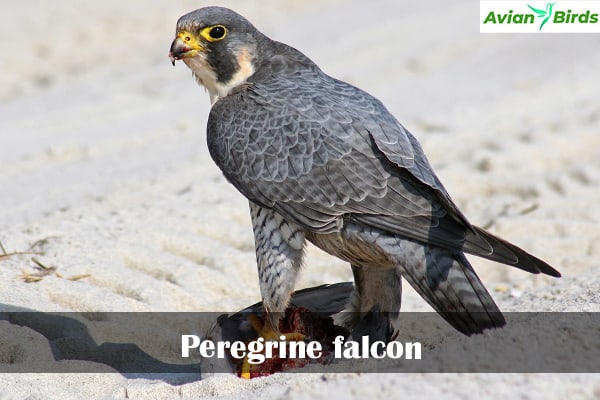
In Arizona, peregrine falcons have made an impressive comeback after facing near-extinction due to DDT pesticide use in the mid-20th century. Today, they can be spotted nesting on cliff faces in places like the Grand Canyon and the red rock formations of Sedona. These adaptable birds have also taken to urban environments, using tall buildings as substitute cliffs for nesting and hunting.
Peregrine falcons are master hunters, specializing in catching other birds in mid-flight. Their diet includes a wide variety of species, from small songbirds to larger waterfowl. Using their incredible speed and agility, peregrines often hunt by flying high above their prey before diving down in a spectacular stoop, striking their target with a clenched foot equipped with sharp talons.
2. American Kestrel
- Scientific name: Falco sparverius
- Size: 8.7-12.2 inches in length, 20-24 inch wingspan
- Weight: 2.8-5.8 ounces
- Lifespan: About 5 years in the wild, up to 17 in captivity
- Diet: Insects, small mammals, birds, and reptiles
The American kestrel, often affectionately called the “sparrow hawk,” is the smallest and most colorful falcon in North America. These diminutive raptors are a common sight throughout Arizona, from urban parks to rural farmlands and desert scrublands. With their rusty-red backs and tails, slate-blue wings, and distinctive facial markings, kestrels are easily recognizable even to novice birdwatchers.
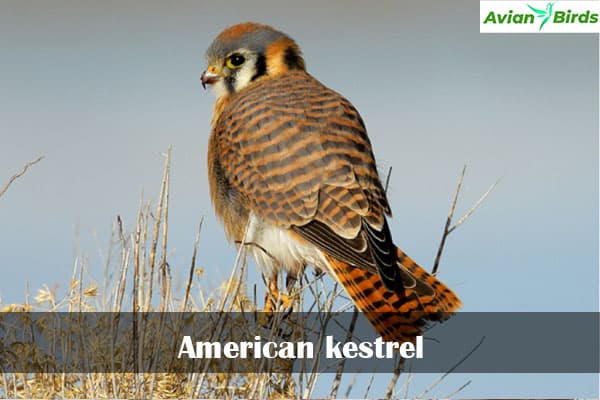
Despite their small size, American kestrels are fierce predators. They have a unique hunting technique, often seen hovering in mid-air with rapid wing beats as they scan the ground for prey. This behavior, known as “kiting,” allows them to spot small movements in the grass or soil below. Once they locate a target, kestrels swoop down with surprising speed and precision.
In Arizona, these adaptable falcons can be found in a variety of habitats. They’re equally at home in the Sonoran Desert, perched on saguaro cacti, as they are in the higher-elevation pine forests of the Mogollon Rim. Kestrels are cavity nesters, often using old woodpecker holes, tree hollows, or artificial nest boxes. Their willingness to use man-made structures has helped them thrive even in urban and suburban areas.
3. Merlin
- Scientific name: Falco columbarius
- Size: 9.4-11.8 inches in length, 20.9-26.8 inch wingspan
- Weight: 5.6-8.5 ounces
- Lifespan: Up to 11 years in the wild
- Diet: Primarily small to medium-sized birds, some insects
The merlin is a compact, powerful falcon that brings a touch of the far north to Arizona during the winter months. These agile hunters are slightly larger than American kestrels but smaller than peregrine falcons. Merlins are known for their dark, slate-gray upper parts and streaked undersides, giving them a fierce, no-nonsense appearance.

While merlins don’t breed in Arizona, they’re regular winter visitors to the state. Birdwatchers eagerly anticipate their arrival each fall, as these falcons migrate south from their breeding grounds in Canada and Alaska. In Arizona, merlins can be found in a variety of open habitats, including grasslands, agricultural areas, and even urban parks.
What merlins lack in size, they make up for in attitude and hunting prowess. These falcons are known for their aggressive pursuit of prey, often chasing birds at high speed, twisting flights through the air. Their preferred hunting method involves surprising their targets from behind or below, using their exceptional maneuverability to outfly their prey.
4. Crested Caracara
- Scientific name: Caracara plancus
- Size: 19.7-23.6 inches in length, 4-foot wingspan
- Weight: 1.8-2.9 pounds
- Lifespan: Up to 30 years in captivity
- Diet: Carrion, small mammals, birds, reptiles, and insects
The crested caracara, sometimes called the “Mexican eagle,” is a unique and striking member of the falcon family. With its bold black and white plumage, bright orange face, and distinctive crest, the caracara stands out among Arizona’s raptors. These birds are something of an oddity in the falcon world, behaving more like vultures in many ways.
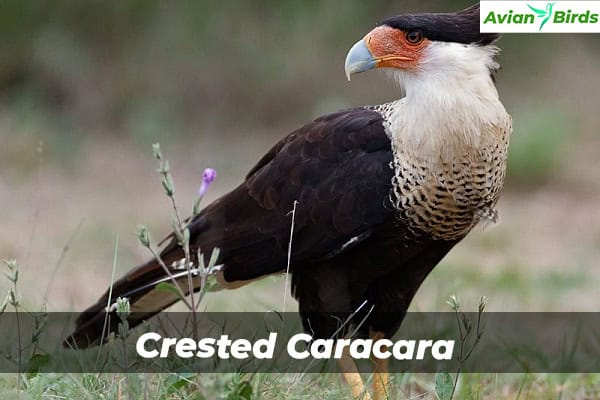
In Arizona, crested caracaras are most commonly found in the southern part of the state, where the Sonoran Desert transitions into grasslands and mesquite savannas. They prefer open country with scattered trees or cacti for perching and nesting. Unlike other falcons, caracaras spend a lot of time on the ground, walking with an ungainly gait as they search for food.
Caracaras are opportunistic feeders, and their diet reflects this adaptability. While they do hunt live prey, they’re also not above scavenging carrion, often seen alongside vultures at roadkill or other carcasses. This diverse diet helps them thrive in areas where other raptors might struggle. Caracaras are also known for their intelligence and have been observed using tools and engaging in complex social behaviors.
5. Prairie Falcon
- Scientific name: Falco mexicanus
- Size: 14.6-18.5 inches in length, 3.3-3.6 foot wingspan
- Weight: 1.1-2.5 pounds
- Lifespan: Up to 13 years in the wild
- Diet: Small mammals, birds, and some reptiles
The prairie falcon is a bird built for wide-open spaces, perfectly adapted to life in the arid landscapes of the American West. In Arizona, these falcons can be found in desert grasslands, sagebrush flats, and open mountain areas. With their sandy-brown coloration, dark “armpit” patches, and mustache-like markings, prairie falcons blend seamlessly into their surroundings.
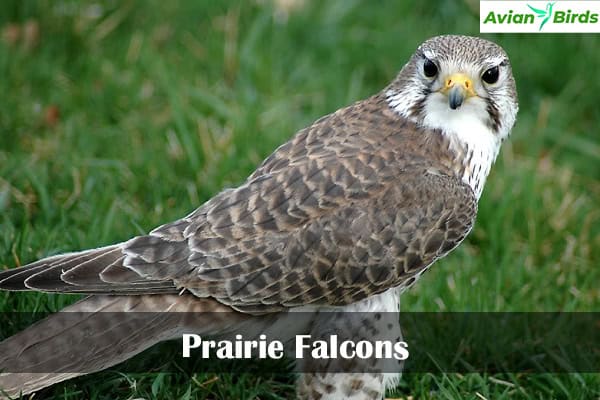
These falcons are swift and powerful flyers, capable of covering vast distances in search of prey. Unlike peregrine falcons, which specialize in catching birds in flight, prairie falcons are more versatile hunters. They often employ a technique called “contour hunting,” flying low over the landscape to surprise ground-dwelling prey like rabbits, ground squirrels, and small birds.
In Arizona, prairie falcons face challenges from habitat loss and human disturbance. However, conservation efforts have helped stabilize their populations. These resilient birds have even adapted to using man-made structures like bridges and buildings for nesting, though they still prefer natural cliff faces when available.
Where to Look for Falcons in Arizona
Arizona’s diverse landscapes offer numerous opportunities to observe falcons in their natural habitats. Here are some prime locations and tips for spotting these magnificent birds:
- Grand Canyon National Park:
- Sonoran Desert National Monument
- Chiricahua National Monument
- Patagonia Lake State Park
- Urban Parks and Golf Courses
- Agricultural Areas
- Riparian Areas
Tips for Falcon Watching:
- Timing is key: Early morning and late afternoon are usually the best times to spot falcons, as they’re most active during these cooler hours.
- Bring binoculars: Falcons can be difficult to spot with the naked eye, especially when perched. A good pair of binoculars is essential for getting a close-up view.
- Learn their calls: Familiarize yourself with the vocalizations of different falcon species. Sometimes you’ll hear a falcon before you see it.
- Be patient: Falcon watching often requires patience. Find a good vantage point and settle in for a wait – the payoff can be spectacular.
- Respect their space: Always observe falcons from a distance to avoid disturbing them, especially during nesting season.
- Join a birding group: Local Audubon chapters and birding clubs often organize field trips led by experienced guides who can help you spot and identify falcons.
Read More🐦Related Articles:
- Hawks in Hawaii
- Hummingbirds in Oklahoma
- What Does Three Little Birds Mean?
- Shima Enaga Bird: Everything You Need To Know
- 150+ Cool Bird Names
Conclusion
From the lightning-fast peregrine falcon to the curious and adaptable crested caracara, Arizona’s falcons represent some of nature’s most impressive avian achievements. These birds have not only survived in the state’s challenging and diverse environments but have thrived, adapting to everything from scorching deserts to urban landscapes.
As we’ve explored, each falcon species brings its own unique characteristics and behaviors to Arizona’s ecosystem. Whether you’re watching a tiny American kestrel hovering above a field, or marveling at a prairie falcon soaring over vast desert expanses, these birds offer endless opportunities for wonder and appreciation.

